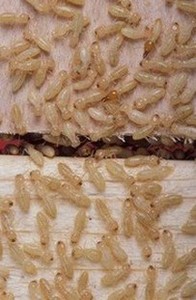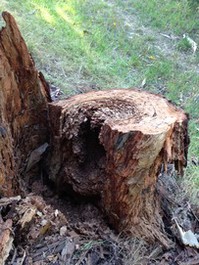About Termites and White Ants
In Your Home
Termites, commonly known as white ants, play an important role in recycling timber in the environment and returning nutrients to the soil. It is only when they gain access and cause damage to our homes that they are deemed pests.
Houses provide termites with ideal conditions combining warmth, moisture and a plentiful food source. Termites access homes via concrete or timber stumps, footings and concrete steps, and can access cracks, joins, pipe penetrations or up the outer edge of slabs or footings as small as 0.8 mm. They love damp areas such as hot water systems and air conditioners and leaking gutters.
Subterranean (soil dwelling) termites live in colonies with sizes up to a million. Each colony contains a king and queen, soldiers, workers and alates (flying termites). The queen produces new offspring and can lay up to 2000 eggs per day. The workers are the most numerous termites in the colony. The are approximately 5 mm in length, are a creamy-white colour with a round head, wingless and blind. The workers are responsible for obtaining food and water for the colony, and are the termites which damage your home. They collect the timber and take it to the nest to feed the colony.
The workers also construct the mud tunnels, and groom other termites. The soldiers look similar to workers, but have brownish head in colour and have jaws. Soliders are responsible for colony defence and achieve this by spitting a sticky substance on predators, and by bitting with their jaws.
Termites travel through the soil and build mud tunnels to protect them from the elements when travelling up to 50 meters or more from their nest. Mud tunnels can range from 10 mm to 80 mm wide and are most commonly found in the sub floor areas of raised buildings, and constructed over barriers such as exposed concrete slab edges, brickwork or foundation posts.
Houses provide termites with ideal conditions combining warmth, moisture and a plentiful food source. Termites access homes via concrete or timber stumps, footings and concrete steps, and can access cracks, joins, pipe penetrations or up the outer edge of slabs or footings as small as 0.8 mm. They love damp areas such as hot water systems and air conditioners and leaking gutters.
Subterranean (soil dwelling) termites live in colonies with sizes up to a million. Each colony contains a king and queen, soldiers, workers and alates (flying termites). The queen produces new offspring and can lay up to 2000 eggs per day. The workers are the most numerous termites in the colony. The are approximately 5 mm in length, are a creamy-white colour with a round head, wingless and blind. The workers are responsible for obtaining food and water for the colony, and are the termites which damage your home. They collect the timber and take it to the nest to feed the colony.
The workers also construct the mud tunnels, and groom other termites. The soldiers look similar to workers, but have brownish head in colour and have jaws. Soliders are responsible for colony defence and achieve this by spitting a sticky substance on predators, and by bitting with their jaws.
Termites travel through the soil and build mud tunnels to protect them from the elements when travelling up to 50 meters or more from their nest. Mud tunnels can range from 10 mm to 80 mm wide and are most commonly found in the sub floor areas of raised buildings, and constructed over barriers such as exposed concrete slab edges, brickwork or foundation posts.

Termite damage is often not immediately evident as termites feed by excavating galleries inside the timber, often leaving a paper thin layer of timber held together by paint or varnish. The timber will often have a rippled appearance.
Flying termites swarm in order to find a mate and establish new colonies, and this is often a warning sign that you may have a termite nest nearby. Flying or reproductive termites will swarm over a brief period, usually from late October through the summer months. These termites have two pairs of wings, which they shed once their flight is over. Termite flights are currently being reported in all areas of Melbourne.
Flying termite information
There are many things that you can do around your home to make it less attractive to termites. Find out our top tips for looking after your home.
